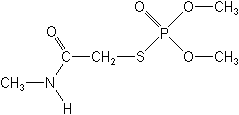-
Common NameOmethoate
-
中文通用名氧乐果
-
IUPAC2-dimethoxyphosphinoylthio-N-methylacetamide
or
O,O-dimethyl S-methylcarbamoylmethyl phosphorothioate -
CASO,O-dimethyl S-[2-(methylamino)-2-oxoethyl] phosphorothioate
-
CAS No.1113-02-6
-
Molecular FormulaC5H12NO4PS
-
Molecular Structure
-
Category
-
ActivityInsecticide, acaricide
-
PremixTriadimefon+omethoate
Imidacloprid+omethoate
Fenvalerate+omethoate
Fenpropathrin+omethoate
Dichlorvos+fenvalerate+omethoate
Deltamethrin+omethoate
Beta-cypermethrin+omethoate
-
Physical PropertiesMolecular weight:213.2; Physical form:Colourless liquid, with a mercaptan odour. Density:1.32 (20℃); Melting point:Solidifies -28 ℃ (tech.); Flash point:128 ℃( tech.); Vapour pressure:3.3 mPa (20℃); Partition coefficient(n-octanol and water):logP = -0.74 (20℃); Solubility:Readily soluble in water, alcohols, acetone, and many hydrocarbons. Slightly soluble in diethyl ether. Almost insoluble in petroleum ether.; Stability:Hydrolysed in alkaline media; relatively slowly hydrolysed in acidic media: DT50 (est.) 102 d (pH 4), 17 d (pH 7), 28 h (pH 9) (22 ℃).
-
ToxicologyOral:Acute oral LD50 for rats c. 25 mg/ kg. Percutaneous:Acute percutaneous LD50 (24 h) for male rats 232, female rats c. 145 mg/kg. Not irritating to the skin; slightly irritating to the eyes (rabbits). Inhalation: LC50 (4 h) for rats c. 0.3 mg/l (aerosol). Phytotoxicity:May be phytotoxic to some varieties of peach.
-
Environmental ProfileEcotoxicology: Algae: ErC50 for Scenedesmus subspicatus 167.5 mg/l.Bees:Toxic to bees.Birds:Acute oral LD50 for male Japanese quail 79.7, female Japanese quail 83.4 mg/ kg.Daphnia: LC50 (48 h) 0.022 mg/l.Fish: LC50 (96 h) for golden orfe 30, rainbow trout 9.1 mg/l.Worms: LC50 for Eisenia foetida 46 mg/ kg dry soil. Environmental fate: Animals:Omethoate is not accumulated in animal tissues or fat. The main metabolites in the urine are O-demethylomethoate and N-methyl-2-(methyldithio)acetamide.Soil:Omethoate has a relatively high mobility in soil but is very rapidly metabolised;
50 only a few days. The main metabolite is CO2. Aged leaching studies revealed that metabolites have only a low leaching potential.Plant:Omethoate is rapidly taken up by plants. Demethylation and hydrolysis of P-S bonds are the main metabolic steps. The main metabolites are 3-hydroxy-3-[(2-methylamino-2-oxo-ethyl)thio]propionic acid and its oxidation products. WATER SOLUBILITY: Readily Soluble -
Transport InformationSignal Word:DANGER; Hazard Class:Ib(Highly hazardous)
Porduct NewsMore
Australia bans omethoate on food producing crops
India CIBRC 350th meeting approved 19 pesticide technical registrations
Tricyclazole Myclobutanil Metconazole Thiamethoxam Buprofezin Indoxacarb Omethoate Spirotetramat Metribuzin Imazethapyr Pyrazosulfuron-ethyl Propyzamide Metamitron Diflubenzuron Quinalphos

 0
0 Subscribe
Subscribe
